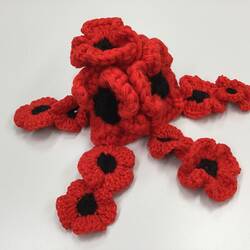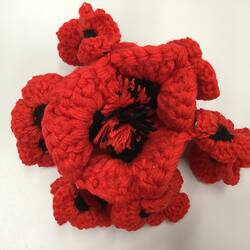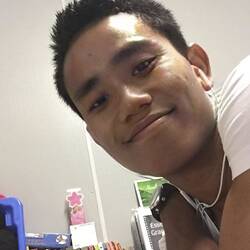Summary
Crocheted table centre featuring red and black poppies created by Aung Saw Lim (Man Man) at Manus Island detention centre. It was made by Man Man in honour of Remembrance Day in 2017. He had found about a community effort that started in Melbourne in 2013 called the 500 Poppies Project to pay respect and remembrance for soldiers. A Facebook friend suggested that he crochet some poppies for the display in Canberra. Unfortunately his poppy piece did not make it to Canberra for that occasion as there was a blockade and removal of all men on Manus at the time.
Aung Saw Lim (family nickname Man Man) was a refugee from Myanmar, detained on Manus Island from 2013. He learned the craft of crochet through a case worker during his years of detention on Manus. He was offered lessons on Manus and developed friendships on Facebook with others that shared his interest in crocheting. While on Manus he developed his craft. He would gift and share his craft with others including Jill Parris. Jill wrote in their co-authored self-published book, "Man Man: Making Meaning on Manus" (9/12/2017) that he found the "rhythmic activity helped him relax, kept him occupied for hour upon endless hour and used his innate skills with colour and form." After four and a half years, Man Man was accepted for asylum in the United States in 2018, as a part of the intake of refugees from Manus negotiated between the Australian and United States governments.
Physical Description
Red and black woollen crochet with three large central poppies stitched together to form a central dome with a poppy on top. There are five prongs of two poppies each radiating from the central dome of poppies.
Significance
Statement of Historical Significance:
Man Man's crochet work, experience as a detainee, and friendship on Facebook with Jill Parris speaks to the cultural and historical changes in contemporary Australia. Manus and Nauru have become a part of Australian immigration history as indicative of a time when Australian immigration policies changed significantly. Man Man's friendship on Facebook with Jill Parris represents a history shift in the culture of activism and public involvement as an Australian citizen in protest and support of asylum seekers in Australian contemporary immigration history. Their stories are of contemporary local and global significance as the Australian public actively engage stories and experiences of detainees of Manus and Nauru seeking asylum in Australia. International human rights monitors and countries all over the world are considering Australia's model and leadership in highly protectionist immigration policy. The fact that Man Man has since been accepted to America ties the story to the global scope of influence of these life stories and their impact on national and international Australian immigration politics.
Man Man's friendship and story with Jill Parris encapsulate the historical changes in cultural and political everyday life and history of activism in Australia. The objects and their friendship on Facebook speak to changing expressions of gender and friendship in modern Australia. Man Man is a man who crochets, a craft which is a traditionally a feminine expression of preoccupying the mind and deterring dire outcomes in waiting or captivity. This feminine archetypal craft goes back to the vision of Penelope weaving burial shroud while waiting for return of her husband in Homer's Odyssey. While Man Man is not crocheting as an act of fidelity to a partner, he certainly is doing it to preoccupy his mind in captivity and trying to ward off more dire outcomes.
Another aspect of the cultural significance of everyday cultural and political histories of Australian life is their friendship on Facebook. Jill and Man Man begin and continue in friendship through mutual admiration of their photographs on Facebook. Jill speaks about how his photographs inform her own work and that it was not with intention that she get to know his circumstances or status in detention. What evolves is a friendship between an older white Australian woman with a young Myanmar man via Facebook. Facebook as a social media facilities this friendship and their real life connections, a contemporary phenomenon that has not been highly historicised. Social media's role in the history of contemporary migration in terms of access for the diaspora living in displacement and its users in captivity or detention also informs Australian public consciousness and activism. In the history of activism, social media has informed Australian public of conditions otherwise not known and created friendship and networks of support that become a part of refugee and migrants lives in Australia. Man Man and Jill's friendship is situated in this contemporary cultural history.
More Information
-
Collecting Areas
Migration & Cultural Diversity, Clothing & Textiles, Politics & Society
-
Maker
-
Owner
-
Classification
Migration, Processing - immigration selection, Refugee camps
-
Category
-
Discipline
-
Type of item
-
Object Dimensions
130 mm (Length), 330 mm (Width)
-
Keywords
Refugees, Asylum Seekers, Detention Centres, Activism, Artworks, Crafts, Crocheting, Wars & Conflicts




